Seven calming water workouts can help you release stress and tension while nurturing your mind-body connection. You'll find peace through swimming gentle laps, practicing water walking meditation, and exploring floating mindfulness exercises. Aqua yoga stretches target key muscle groups while the water's buoyancy supports your movements. Wave movement therapy lets you surrender to water's natural rhythm, while pool noodle relaxation provides supported stretching. Deep water breathing exercises enhance your relaxation response through controlled breathing patterns. These water-based techniques offer a gateway to deeper levels of stress relief and rejuvenation.
Swimming Gentle Laps
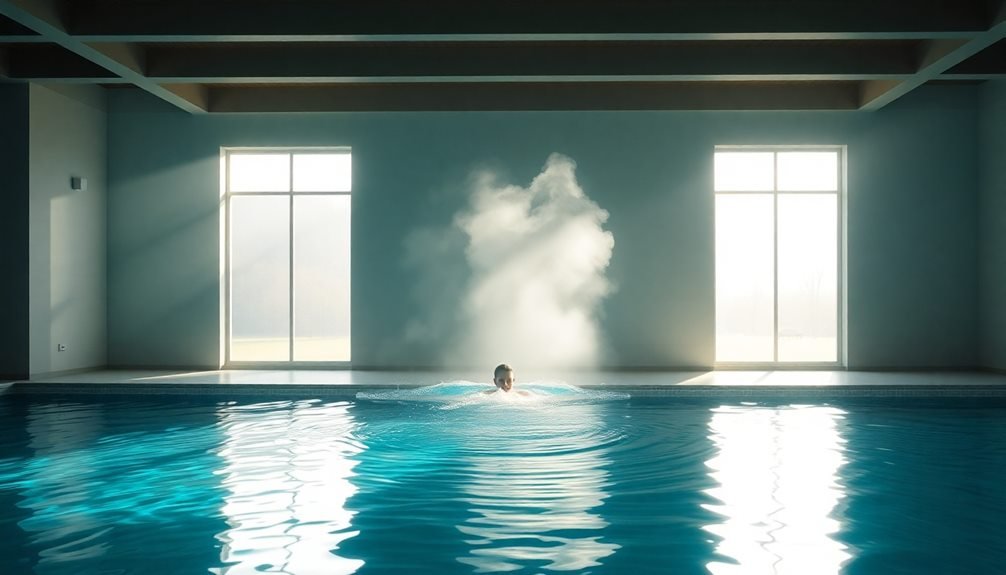
After a long day, swimming gentle laps provides one of the most effective full-body stress relievers you'll find. The rhythmic motion of your arms and legs through the water creates a meditative state, while the water's natural resistance helps release muscle tension throughout your body.
Start with a slow breaststroke, focusing on your breathing pattern. As you glide through the water, synchronize your inhales and exhales with each stroke. The water's buoyancy supports your joints, making this a zero-impact exercise that won't strain your body. You'll notice your shoulders relaxing and your mind clearing as you establish a steady pace.
If you're new to lap swimming, try alternating 25-meter lengths with short rest periods. Keep your movements fluid and unhurried – this isn't about speed or distance. Instead, concentrate on maintaining proper form and allowing the water to massage your muscles as you move.
The cool temperature of the pool helps reduce inflammation and anxiety, while the gentle exercise releases endorphins that elevate your mood. Within 20-30 minutes of swimming gentle laps, you'll feel both physically and mentally refreshed.
Water Walking Meditation
You'll experience a remarkable sense of serenity as you deliberately walk through chest-deep water, letting each mindful step ground you in the present moment.
Moving in slow motion against the water's natural resistance creates a perfect environment for releasing muscle tension and mental stress.
As you flow through the water with purposeful movements, you're entering a peaceful state where worries seem to dissolve with each meditative step.
Slow Motion Creates Calm
Gliding through water at a snail's pace creates a uniquely meditative experience. As you deliberately slow down your movements, you'll notice how the water gently resists and flows around your body, creating a soothing sensation that helps quiet your mind.
Start by standing chest-deep in the pool and lifting your arms slowly through the water, as if you're moving through honey. You'll feel the water's natural resistance challenging your muscles while simultaneously calming your nervous system.
Practice moving each limb with purposeful slowness – raise your knee, extend your leg, and place your foot down with concentrated attention.
You can enhance this practice by coordinating your breath with your movements. As you push your arms forward, inhale deeply for four counts. When pulling them back, exhale for four counts.
This slow-motion exercise isn't about building strength or burning calories – it's about creating a moving meditation that helps release tension and anxiety. You'll find that the slower you move, the more you'll tune into the water's therapeutic properties, allowing stress to dissolve with each mindful movement.
Flow Through Pure Peace
The art of water walking meditation transforms an ordinary pool into a sanctuary of serenity. As you move through chest-deep water, you'll focus on each deliberate step while synchronizing your breath with your movement. This mindful practice combines the therapeutic properties of water with meditation's calming benefits.
Start at the pool's shallow end and walk heel-to-toe, keeping your shoulders relaxed and arms floating naturally at your sides. You'll notice how the water's resistance creates a gentle massage effect while supporting your body weight. As you inhale for four counts, take two steps forward; as you exhale for four counts, take two more steps.
To deepen your practice, direct your attention to specific sensations: the water's temperature against your skin, the subtle currents around your legs, and the feeling of weightlessness.
When thoughts arise, acknowledge them without judgment and return your focus to your breathing and movement. You can practice this meditation for 10-20 minutes, gradually building your session length as you become more comfortable with the technique.
Floating Mindfulness Exercise
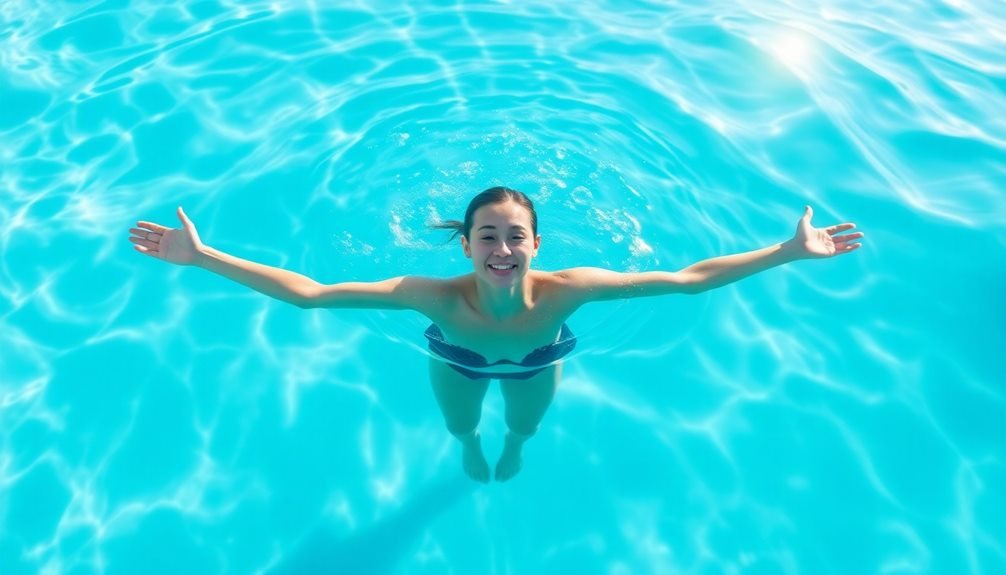
Along with vigorous water exercises, floating meditation offers a deeply calming way to release tension.
Begin by gently floating on your back, either in a pool or natural body of water, using foam noodles or simply allowing your body's natural buoyancy to support you. Focus on maintaining a horizontal position with your ears submerged while keeping your face above water.
As you float, direct your attention to your breathing pattern. Notice how your chest rises and falls with each breath, creating small ripples in the water. Let your arms drift naturally at your sides, palms facing upward. You'll feel a subtle oscillation as the water gently rocks your body.
Now, systematically scan your body from head to toe, consciously releasing tension from each muscle group. Pay particular attention to areas where you typically hold stress – your jaw, shoulders, and lower back.
The water's temperature and gentle pressure against your skin serve as anchor points for your awareness. If your mind wanders, return your focus to the sensation of floating and your breath.
Practice this exercise for 10-15 minutes, allowing the water to wash away your stress.
Aqua Yoga Stretches
Building on the meditative benefits of floating, aqua yoga stretches combine gentle movements with water's natural resistance. You'll find that performing yoga poses in water reduces joint stress while enhancing flexibility and balance. Stand in chest-deep water and maintain steady breathing throughout each movement.
| Pose Name | Technique | Benefits |
|---|---|---|
| Water Warrior | Step one leg forward, bend knee, arms outstretched | Strengthens legs, improves balance |
| Pool Tree | Stand on one leg, place other foot on inner thigh | Enhances core stability, focus |
| Floating Dog | Hold pool edge, walk feet back, form triangle | Lengthens spine, stretches hamstrings |
| Aqua Twist | Stand tall, rotate torso, arms follow movement | Releases back tension, aids digestion |
| Wave Cobra | Face pool wall, arch back, arms extended | Opens chest, relieves shoulder strain |
Perform each pose for 30-60 seconds, focusing on smooth shifts between movements. You'll notice the water's buoyancy helps deepen stretches while providing gentle resistance. As you progress, try linking poses together in a flowing sequence, allowing the water's rhythm to guide your movement patterns.
Wave Movement Therapy
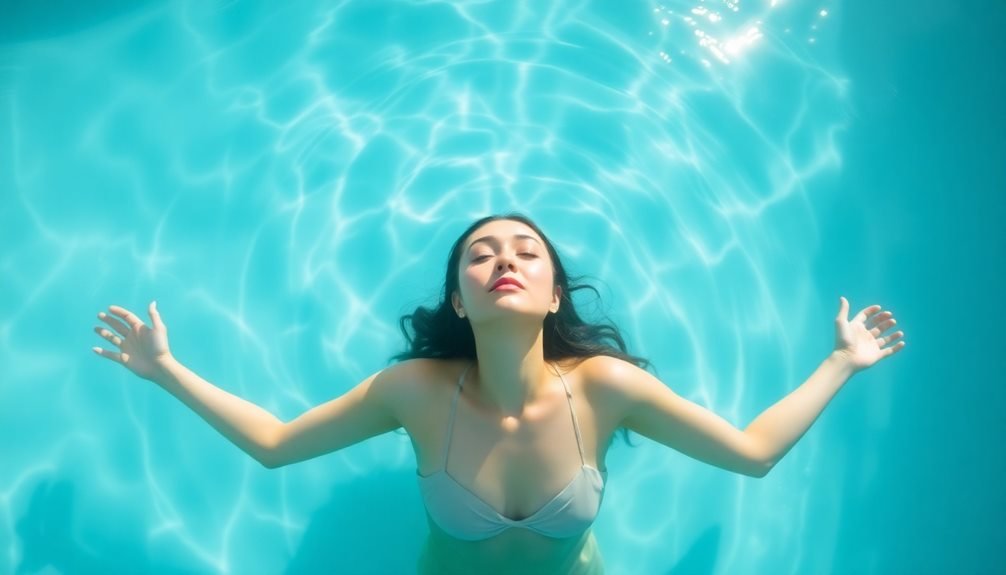
Wave movement therapy lets you surrender to the water's natural rhythm as you float and gently sway from side to side.
You'll feel the gentle rolling motions massage your muscles while the water supports your body weight.
As you move with the waves, you can release physical and mental tension, allowing stress to drift away with each gentle bob and sway.
Gentle Rolling Motions
Through gentle rocking motions in the water, you'll experience one of aquatic therapy's most soothing exercises. As you stand in chest-deep water, begin swaying side to side, letting your arms float naturally. This movement mimics the ocean's natural rhythm, helping release tension in your shoulders and lower back.
To maximize the therapeutic benefits, keep your feet planted shoulder-width apart and bend your knees slightly. As you roll from side to side, focus on maintaining a steady, controlled pace. You'll feel the water's resistance massaging your muscles while supporting your body weight. The gentle pressure helps decompress your spine and joints, providing relief from everyday stress.
Try incorporating arm movements by raising them slightly as you sway, letting them drift with the water's flow. You can intensify the exercise by deepening your stance or slowing down the rolling motion.
For best results, perform this exercise for 5-10 minutes, synchronizing your breathing with each movement. If you're feeling particularly tense, combine these rolling motions with slow, deep breaths to enhance the calming effect.
Float and Release Tension
Serenity washes over you as you enter the float position on your back, letting the water fully support your body. As you drift, focus on releasing tension from each muscle group, starting from your toes and moving upward. You'll feel the water gently cradling your spine, naturally aligning your posture while reducing pressure on your joints.
To enhance this floating meditation, extend your arms slightly away from your body, palms facing upward. Take slow, deep breaths, and you'll notice how your chest rises slightly with each inhale, creating tiny ripples in the water. If you're in a pool, use pool noodles under your knees and neck for added support and comfort.
When you're ready to deepen the relaxation, try the "starfish float." Spread your arms and legs wider, forming a star shape. This position helps distribute your weight evenly and maximizes the water's buoyant effect.
You'll find that this expanded position allows you to focus on areas of stored tension, particularly in your lower back and shoulders. Hold this position for 3-5 minutes, letting each exhale carry away stress and muscle tightness.
Pool Noodle Relaxation
A pool noodle can become your secret weapon for melting away tension in the water. This versatile foam tool supports your body while you perform gentle stretches and relaxation exercises. Place it under your arms, across your back, or behind your neck to create a floating sensation that helps release muscle tension.
Try the "noodle drift" exercise by positioning the pool noodle under your armpits and letting your legs float freely. Close your eyes and allow the water to gently rock you, focusing on deep breathing. You'll feel your shoulders and neck muscles begin to loosen as you surrender to the water's buoyancy.
For a deeper stretch, straddle the noodle like a horse and lean back until you're floating on your back. The noodle will support your hips while your spine elongates in the water. Hold this position for 30-60 seconds, breathing slowly and steadily.
You can also try the "figure-eight float" by wrapping the noodle around your upper back and under your arms, then moving your legs in a gentle figure-eight pattern to create a soothing, rocking motion.
Deep Water Breathing
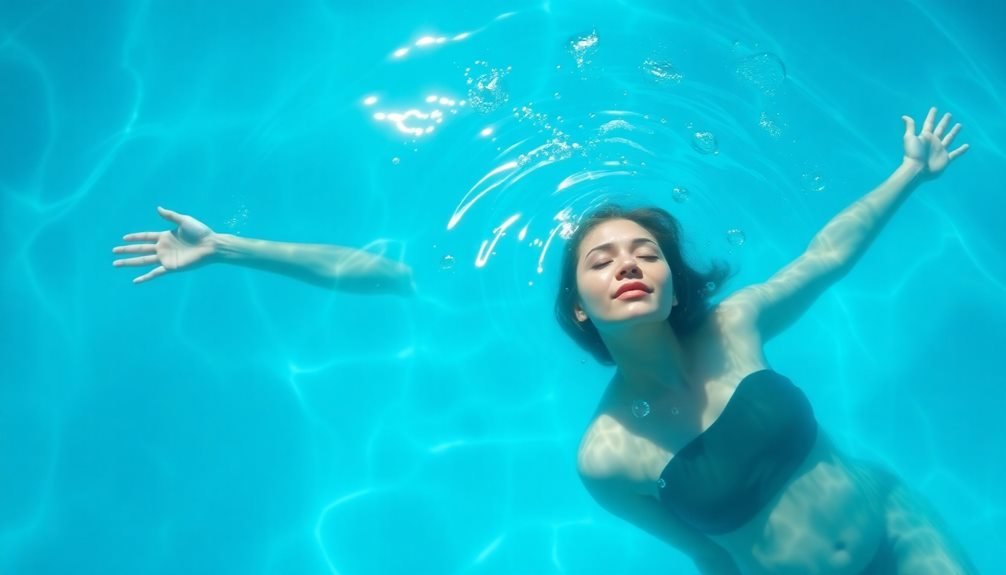
Tranquil bubbles rise to the surface as you master deep breathing exercises in the pool's calming embrace. The water's natural resistance helps you focus on each breath, creating a meditative state that melts away tension and anxiety.
Start by finding a spot where the water reaches your shoulders. Plant your feet firmly on the pool floor, keeping your knees slightly bent. As you inhale deeply through your nose, slowly lift your arms out to the sides, letting the water's buoyancy support your movement. Hold your breath for three counts, then exhale gradually through your mouth while lowering your arms.
You'll notice how the water pressure against your chest naturally deepens your breathing pattern. Try submerging your mouth just below the surface as you exhale, creating gentle ripples that reinforce your rhythm. This technique, known as hydrostatic breathing, can lower your heart rate and reduce cortisol levels.
For maximum benefit, perform this exercise for 10-15 minutes. You can also combine it with gentle walking or marching in place to enhance circulation while maintaining the stress-relieving benefits of controlled breathing.
Frequently Asked Questions
How Long Should I Wait After Eating Before Starting Water Workouts?
You'll want to wait at least 2-3 hours after a large meal before swimming or doing water workouts. If you've had a light snack, wait about 30 minutes to avoid cramps and discomfort.
What Temperature Is Ideal for Stress-Relieving Water Exercises?
You'll find ideal stress relief in pool water between 83-88°F (28-31°C). Your muscles relax best at these temperatures, and you won't feel too cold or too warm during your water exercises.
Can I Do Water Workouts if I'm Not a Strong Swimmer?
You can absolutely do water workouts even if you're not a strong swimmer. Just stick to shallow areas where you can touch the bottom, and consider wearing a flotation belt for extra security.
Are Water Workouts Safe During Pregnancy?
Water workouts are typically safe during pregnancy, but you'll need your doctor's approval first. You can enjoy low-impact exercises like water walking, swimming, and aqua aerobics to stay active while protecting your joints.
Should I Wear Special Gear for Therapeutic Water Exercises?
You'll need water shoes for grip, a comfortable swimsuit, and goggles if going underwater. For therapeutic exercises, consider using water weights, pool noodles, or resistance bands designed specifically for aquatic workouts.
In Summary
You'll find that water workouts offer a unique combination of physical activity and stress relief that's hard to match on land. Whether you're floating peacefully or moving mindfully through the water, these seven exercises can help wash away tension and anxiety. Make these aquatic techniques part of your regular self-care routine, and you'll discover why water has long been associated with healing and tranquility.

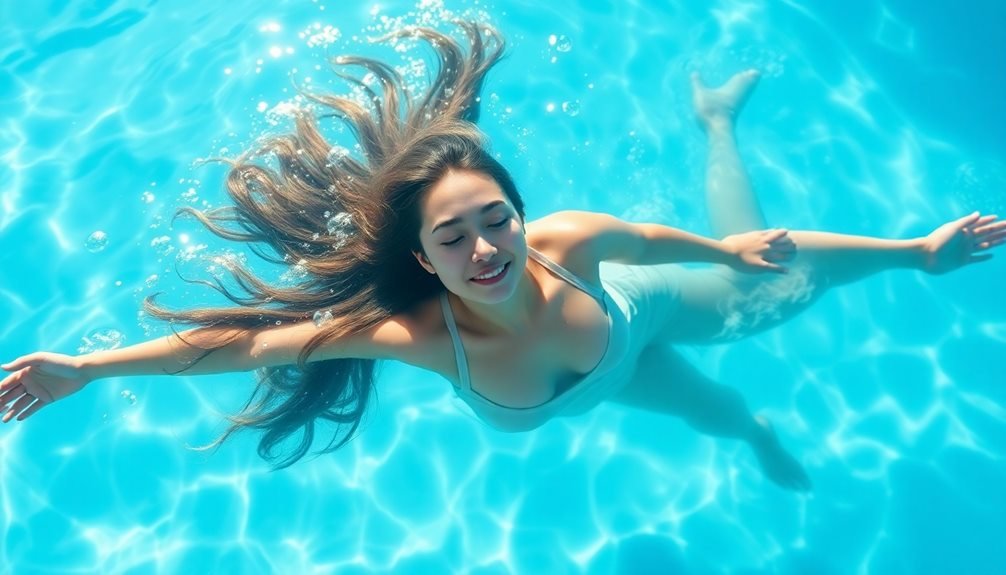
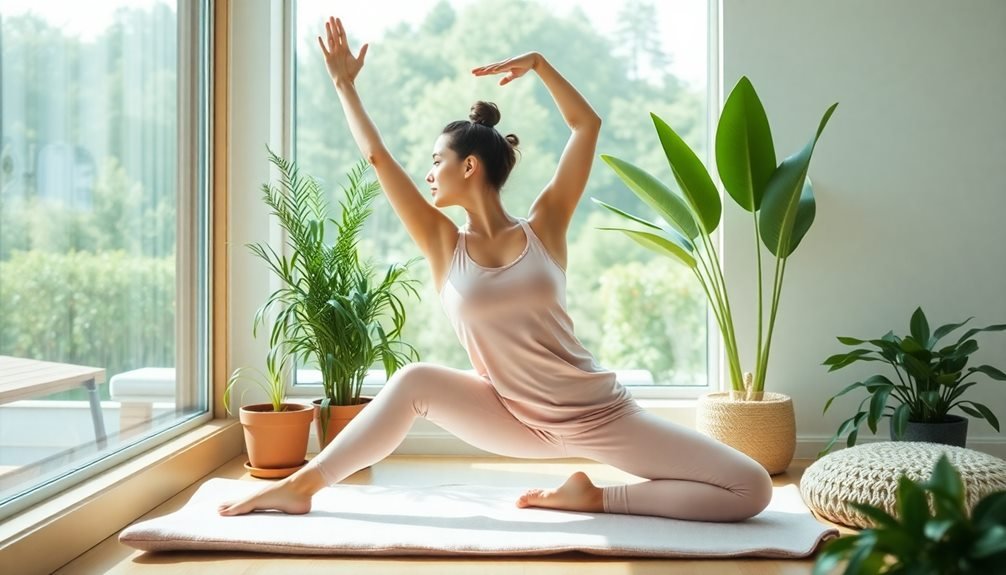
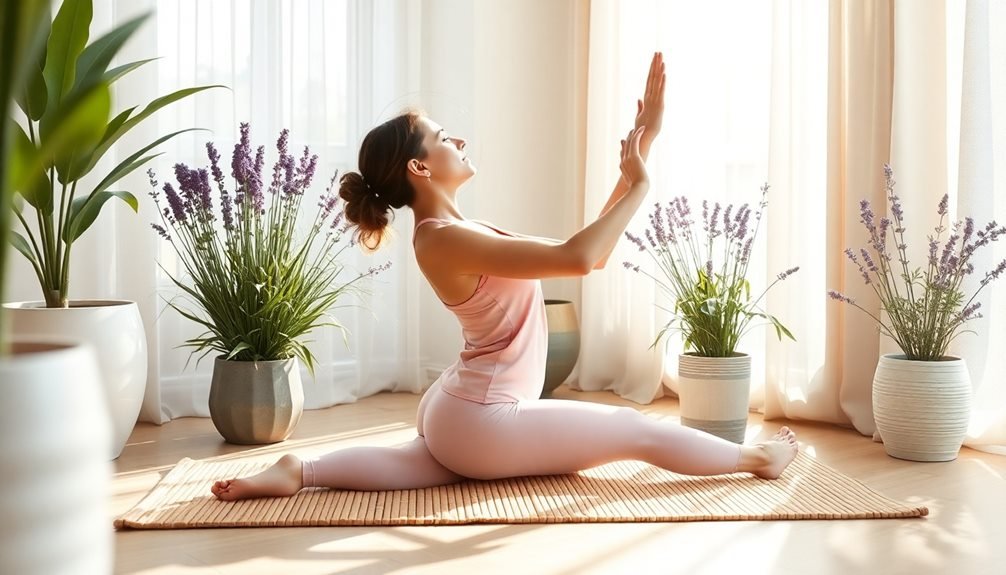
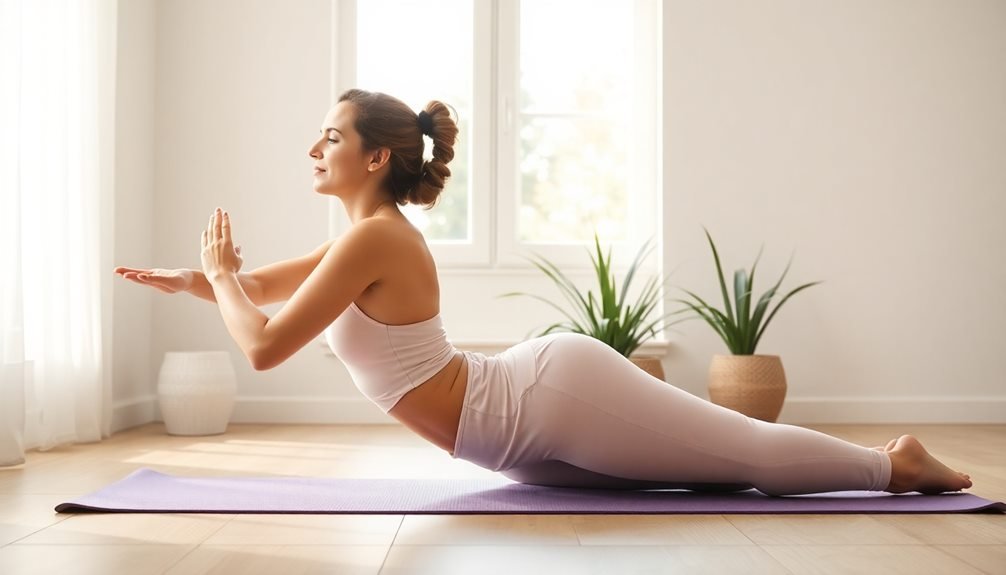
Leave a Reply